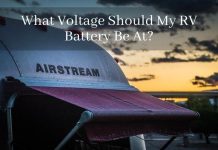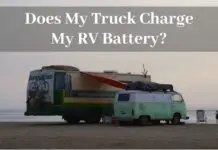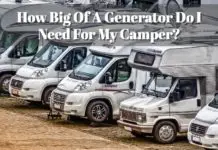
It’s holiday, and one thing that keeps ringing in your head is what you will do with the free days. With the many days left at your disposal, it’s allowed to have some time spent with the family. Often, most families prefer camping or a road trip. These two activities never disappoint when it comes to holiday satisfaction. They allow experiencing and discovering new places.
The relaxations that come with having a camping session are hard to forget. With an RV at your disposal, you can never regret organizing the activities. When it comes to RV, you have to ensure that batteries, especially, are kept in good shape as they are the source of power often.
So, does my RV charge when plugged in all the time? Yes, as long as the batteries are connected to the power supply, they will continue charging.
This is one question you will find many RV owners asking. When the break is over, and you need to park the RV, many people are always tempted to keep the RV’s batteries plugged.
The idea is to ensure that they don’t go flat as this can damage the battery. What many people don’t understand is that they can destroy the battery while trying to save it from dying.
What Happens When the Battery is Plugged in All the Time?
As said earlier, your battery will continue charging as long as it’s connected to the power supply. It means that on one occasion, the battery will be full. So, what happens when it’s filled? If not monitored, this can lead to overcharging. The overcharging can damage your battery while reducing its performance.
Therefore, you should ensure that you monitor the charging now and then. Besides, there are alternative ways of ensuring that the battery has charged all the time. For instance, you can invest in a battery maintainer or a smart charger. These devices are designed to ensure that the battery is kept in a good state of charge, and that means topping up whenever they realize that the charge has reduced.
What Happens When the Battery is Disconnected for an Extended Period?
The essence of an RV is to have things such as refrigerators, ACs, TVs, and other home items while out there in the wilderness. The idea is to ensure that you don’t disconnect with the real world even while enjoying some beautiful sceneries out there. For all these appliances to function, you need power. Often, the battery acts as the source of energy for the RV.
So, what happens if the battery isn’t plugged in for an extended period? Within some time, and based on the capacity, your RV’s battery will be discharged. In other words, the battery will go flat. Having a flat battery is even risky as you may end, missing the importance of the RV. It’s for this reason that you are advised to charge the battery now and then.
Every battery has a recommended percentage, and which should never be run down. For the RVs, deep cycle batteries are the most commonly used. Although these batteries are known for providing steady current, manufacturers advise that they shouldn’t be drained past 50%.
Lithium-ion batteries, on the other end, are also common among the RV owners. Most drivers prefer these models as they are reliable when it comes to the power supply. They can be drained down to about 20% without any failure. You should resist avoiding passing these percentages at all costs.
Well, the battery may not die immediately for running down. But, you must understand that the activity reduces its lifespan. That’s why it’s a good idea to keep the battery plugged in all the time and monitor the charging process.
Can I Charge the Battery Using Various Sources Simultaneously?
Solar panels are economical, and much recommended as a source of power. On the other end, you can as well find electricity supply in the camp center. It’s at such an instance that most RV owners are always asking if they charge their batteries using the two sources at once.
The answer is yes. You can have the battery charged using your solar panels and electricity at the same time. With the two supplies, it means that your battery will get filled up faster. There is nothing to worry about as your system should be able to protect your battery from cases of overcharging.
Sources of Power for Your RV’s Battery
1. Converter
What is the size of your RV? This is one of the first questions you need to ask yourself before concluding on the best way to charge its battery using a converter.
For the small RV’s, which are the most common, they come fitted with a 30 amp hookup. For the larger ones, you will find a 50 amp hook up. When it comes to the small campers or RVs, you can have them hooked up in a 15 to 20 amp power source at your home or the campground.
For the larger RVs, you can source your power from the 30 or 50 amp hookup from the shore power. What if your choice of campground doesn’t have these hookups? What happens next? Well, in such instances, you can source your electricity from a standby generator.
Once the RV is connected to the power supply, the battery will start charging immediately. Besides, you can still use your electrical appliances while the charging is taking place. When connected, the power is sent to the converter/inverter, which then directs the power to your batteries and the 120 VAC breaker panel.
The battery on this instance will hook up to the DC appliances while the breaker panel connects to all your AC outlets. Therefore, if your battery is empty, it means that you could still run all your AC appliances.
If you find this option to be complicated, you can as well remove the batteries and charge them inside your home. If the RV is small, you can drive it to your garage and connect the charger while it’s still in its original position.
Related Articles:
1. Why Does My RV’s Power Converter Drain The Battery?
2. Why Is My RV’s Converter Not Charging The Battery?
2. Alternator
How does a car charge the primary battery? It’s the alternator that does all the work. It helps convert the mechanical energy into electrical energy that is stored in the cell. The alternator starts charging the battery begins immediately, and a belt rotates the alternator. You can also tap power for your RV from the alternator.
This option is highly recommended for those who happen to drive for extended periods. With a long-distance, it means that the alternator will charge your primary battery and still have time to top up the cells in your RV.
When it comes to using an alternator to charge your RV batteries, you must understand that special wiring is needed. You need to charge splitters, and that ensures your primary battery doesn’t run down.
Also, the connection ensures that you don’t use your primary battery to run your RV’s electrical appliances. Therefore, you won’t have trouble starting your RV for problems associated with a flat primary battery.
3. Solar Power
In the recent past, solar energy is increasingly becoming popular. With all the energy from the sun, you can rarely have a flat battery. The good thing with using solar power is that you don’t necessarily need to make a stop for the charging to take place. Another fantastic thing is that most RVs come equipped with solar panels that you can utilize to the fullest.
When it comes to using solar panels, the energy from the sun is collected by the panels and directed to the charge controller. The charge controller is a device that feeds your battery. A charge controller is an essential part of the charging as it helps prevent your battery from overcharging.
Charge controllers fall into two categories. There is the pulse width modulation (PWM), and which is the most common in homes and RV settings. The second type of controller is the maximum power point tracking (MPPT) controller. This charge controller is more efficient as opposed to the PWM.
With the added features, it comes with a higher price tag. The controllers come in different power levels. Therefore, when picking a charge controller for your solar charging, it’s advisable to go for one with more amps than your batteries and solar combined.
4. Wind Power
If you’re lucky enough to live or visit the windy regions, then you can make use of wind energy to add some juice to your batteries. Charging a battery using wind power works in the same way as it’s with a solar panel. In this setting, a wind turbine sends energy to your charge controller, which then charges the battery.
Some people opt to mount wind turbines on their RVs. Well, it’s a good idea, although it’s not efficient and safe. It’s even against the law. Besides, the wind turbines can barely keep up with the extended stress of driving at high speed.
Conclusion
Keeping your RV battery at all times is acceptable. It’s safe, as long as the battery is put into use. Otherwise, a prolonged connection can lead to overcharging. The overcharging, in return, can damage your battery and hence reducing its lifespan. Explained in this article are tricks on how to go about the entire process.
Sources:
1. Can I Keep My Travel Trailer Plugged In All The Time? – Get Ready To Go RVing and Camping





